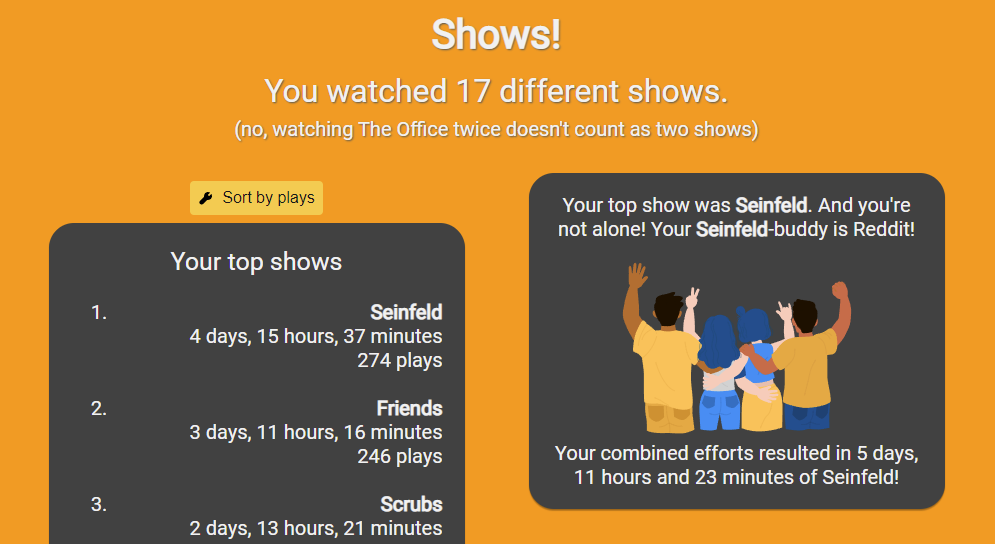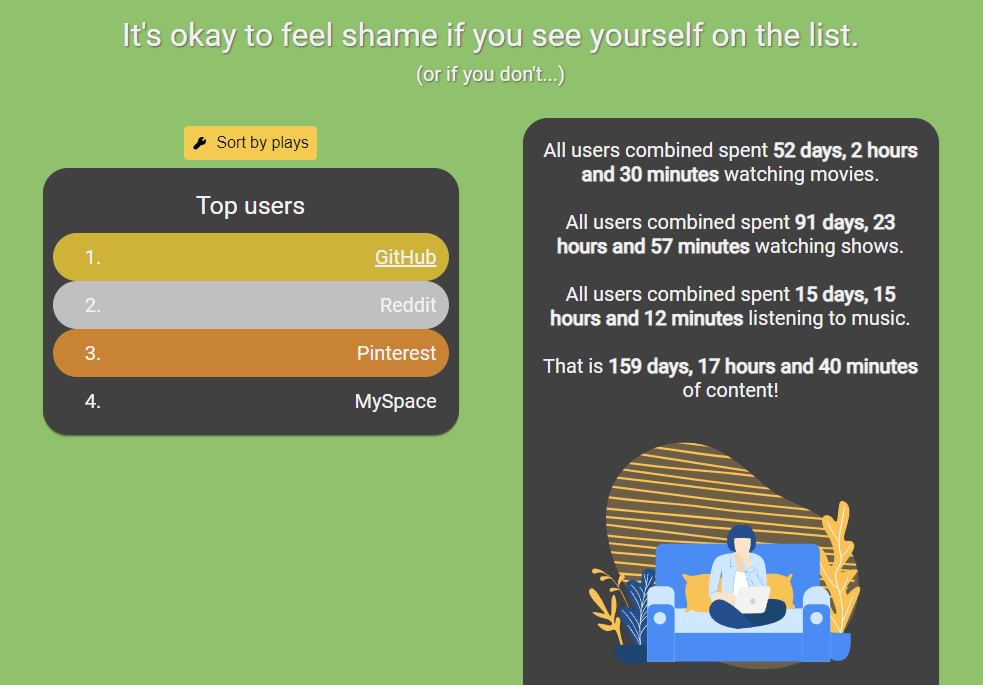| .github/workflows | ||
| .idea | ||
| config | ||
| files | ||
| middlewares | ||
| models | ||
| modules | ||
| routes | ||
| utilities | ||
| web | ||
| .dockerignore | ||
| .gitattributes | ||
| .gitignore | ||
| CODE_OF_CONDUCT.md | ||
| config_default.json | ||
| Dockerfile | ||
| go.mod | ||
| go.sum | ||
| main.go | ||
| README.md | ||
Wrapperr
Like the project? Have too much money? Buy me a coffee or something! ☕️
Introduction - What is this?
A website-based application and API for collecting user stats within a set timeframe using Tautulli. The data is displayed as a statistics summary, sort of like Spotify Wrapped. Yes, you need Tautulli to have been running beforehand and currently for this to work.
Features
- Custom timeframes for statistics
- Plex Auth for login
- Supports multiple Tautulli servers
- Friendly, dynamic presentation of statistics with nice illustrations
- Customizable text options
- Customizable appearance/results
- Statistics for movies, shows & music
- Caching of Tautulli results
- Admin interface for configuration (with regular and HTTP Basic login)
- Pre-caching of results before user interaction
- Shareable links with expiration
Credit
- Beautiful illustrations from FreeWebIllustrations
- Amazing statistics gathered using Tautulli
- Wonderful loading icon from icons8
- Splendid web icons from icons8
- Superb background image from Pexels
Explanation - How does it work?
This is a web-based platform. It gathers and displays statistics using an API (application programming interface) that interacts with the Tautulli API. Install Wrapperr, configure the essential options, and Wrapperr will do the rest. Based on your exact configuration, Wrapperr will gather unique statistics for each user interacting with the application.
In Wrapperr you configure a timeframe, from date-time A to date-time B. This is the timeframe from which the statistics are created. One could for instance have a wrap-up of multiple years of Tautulli data or just a week. If enabled, Wrapperr will verify the user with Plex to ensure personal data is kept private.
Most text is customizable through the Wrapperr admin interface which allows for regional translation. Certain statistics can be disabled and enabled based on relevance/interest. Users can if enabled, generate random URLs which can be shared between friends who want to see each other's statistics.
Instructions - How do I install this?
There are two main ways. Docker information is in the wiki.
Download and start
There are multiple ways to install Wrapperr. The easiest is just to download the latest release from the Release Page which matches your operating system, move all the content to a directory, and start the wrapperr application located within the release. It should start right up, perhaps triggering some operating system or firewall warnings.
Build with Go
If you want to build Wrapperr yourself, you can download whatever version/tag/branch you want, and place the files in a directory. With Go installed, from the Wrapperr directory, run the following commands to build and execute Wrapperr:
$ go build
$ ./wrapperr
Note, if building on another operating system, the executable could have a different name. Such as wrapperr.exe on Windows.
Head to the website
If successful, Wrapperr should be accessible on http://localhost:8282. From there you can click on admin in the footer at the bottom, or go to /admin in the URL. From there you can configure everything about Wrapperr in the different sections of the menu.
Essential configuration options
A couple of configuration options are necessary for Wrapperr to function. First of all, Tautulli connection details. There is a test button available on the page to ensure you have entered the correct details. The second one is the time zone option on the Wrapperr Settings page.
It is recommended to keep Cache results for later use enabled on the Wrapperr Settings page, and head to the Caching page after configuration. Click the Cache button and wait for the caching to finish. This ensures a good, quick user experience.
Wrap away!
Wrapperr should now be functional. Based on your settings, you can now either search with username/e-mail or log in with Plex on the front page. Continue tweaking on the admin menu to get the appearance/language you desire.
More documentation
Docker, TLS, setup information and more can be found in the documentation at the Wiki!
Need help?
If you have any issues feel free to open an issue here on GitHub. I am always trying to improve the project. If I can't, many people on several forums (including /r/plex) might be able to assist you.
Have fun.









